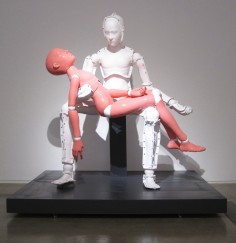Lee Yong Baek
Pieta
source: korean-pavilion.orkr
Lee Yongbaek (b. 1966, Korea), since graduation from the Department of Painting at Hongik University in Korea in 1990, the Department of Painting at Stuttgart State Academy of Art and Design in Germany in 1993, and the Department of Sculpture at the Graduate School of the same university in 1995, has been actively working in Korea and abroad. From the early 1990s, Lee has worked with various technologies, from single-channel video, sound, kinetics, to robotics. Lee is recognized as a representative artist in these artistic fields in Korea. The reason his work is highly evaluated is not only due to his technological experiments, but also his ability to contain the peculiar political and cultural issues of our time and his imagination in the form of these technologies. Recently, Lee has been presenting new works covering a wide range of genres from video art, which he has long been concentrating on, to sculpture and painting. This kind of attempt is one of his strengths. Lee, while maintaining a unity with his existing works, is able to explore the different and does not insist on using only familiar forms. The presentation of his recent works has become an opportunity to effectively arrange and highlight his wide interests, which deal with existence, society, religion and politics.
Angel Soldier is a video performance in which, through the drastic contrast between angel and soldier, without any logical proceedings and explanation whatsoever, directly and frankly expresses the social conditions of our generation. Perceptional and emotional values in an artwork are entirely different from those of an academic study in that an artwork is free from logical proceedings. The strength of directness is like a poem. If a movie is like a novel, than an artwork is like a poem. Lee Yongbaek is an artist who is able to capture this advantage and strength an artwork.
Lee’s other video work Broken Mirror also shows the artist’s characteristic well. Broken Mirror, comprised of a mirror, a flat screen, and a computer, focuses on existence. This simple, yet captivating work displays a mirror seeming to suddenly break with earsplitting sound. In front of it, the viewer questions whether the breaking of the mirror is real or an illusion, indubitably revealing the artist’s strength. This is why life and work process of an artist resemble practices of a Buddhist monk. They both carry out continuous self-reflection and the fruit of continuous self-reflection is born at once. It should not be forgotten that over twenty years of efforts was put in to bear this fruit.
The search for essence and existence continues on in Lee’s recent paintings Plastic Fish. Real, live fish capturing artificial fish for survival, then abducted by its own attempt to survive, and a human being who would be holding a fishing pole between the two, this harsh paradox of existence is neither Chuang Tsu’s The Butterfly Dream, nor Jean Baudrillard’s Simulacres et Simulation. Perhaps it is cruel pain, like eternal punishment that has to be carried upon all living creature’s shoulders.
The series Pieta, pity, will be created in two versions, Pieta: Self-hatred and Pieta: Self-death. This sculpture series uses both the mold (of the sculpture) and the molded figure itself, the mold being the Virgin Mary and the molded figure being the Jesus. In Pieta: Self-hatred, the two figures viciously fight like K-1 fighters, and in Pieta: Self-death, the mold of Virgin Mary holds the dead, molded Jesus. This series metaphorically unfolds contradictions of human existence and the dark barbarism of civilization. Like the sudden summer downpour, Lee Yongbaek’s works carry a chillness that cannot be escaped.
.
.
.
.
.
.
.
source:soitoday
Lee Yong-Baek (sinh năm 1966) là một nghệ sĩ mỹ thuật đương đại đặc biệt của Hàn Quốc hiện nay. Tại Venice Biennale lần thứ 54 vừa qua, ông được lựa chọn là đại diện duy nhất của Hàn Quốc với một gian trưng bày gồm 14 tác phẩm, đủ cả hội họa, nghệ thuật điêu khắc và nghệ thuật sắp đặt.
Quê hương của Lee Yong-Baek là Gimpo, một thành phố nhỏ phía Tây Seoul. Ông về lại quê ngay sau khi xong việc học tập ở Seoul và Stuttgart, Đức, cách đây chừng 20 năm. Ông dựng nhà và xưởng làm việc bằng bê tông trên một quả đồi thấp nhỏ. Xưởng trông như một nhà máy bừa bộn với những cái loa phát thanh quá khổ, màn hình monitor cỡ lớn chất đầy không gian, dưới sàn là tứ tung đủ loại dụng cụ. Lee có nước da sạm nắng, mái tóc rối bù, thân hình vạm vỡ, dẻo dai, giống như một ngư dân hùng hổ hơn là một người theo chủ nghĩa thế giới (cosmopolite) đứng ở tuyến đầu của sáng tạo nghệ thuật với đa dạng chất liệu và công nghệ truyền thông. Ngay khi trở lại Hàn Quốc sau khai mạc Venice Biennale, ông tắt điện thọai di động để đi đánh cá ở ngoài khơi biển phía Nam.


